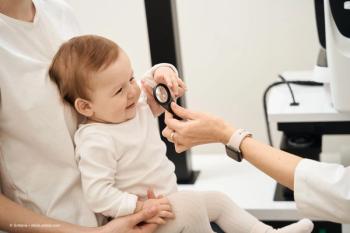
Subretinal implant found to be safe, well-tolerated in patients with advanced dry AMD
This study showed that an investigational subretinal implant, CPCB-RPE1, containing allogeneic human embryonic stem cell-derived RPE cells, was safe and well-tolerated by patients with dry AMD.
Reviewed by Amir Kashani, MD, PhD.
Investigators reported an important first step in a treatment approach to advanced dry age-related macular degeneration (AMD), which to now has been lacking for millions of affected patients worldwide. This study1 showed that an investigational subretinal implant, the California Project to Cure Blindness Retinal Pigment Epithelium (CPCB-RPE1, Regenerative Patch Technologies) containing allogeneic human embryonic stem cell-derived retinal pigment epithelium (RPE) cells was safe and well-tolerated by patients with this type of AMD.
Amir H. Kashani, MD, PhD, lead author of the study, principal investigator of the clinical trial at the University of Southern California, and currently Associate Professor of Ophthalmology, Wilmer Eye Institute, Johns Hopkins University, Baltimore, reported this result at the Angiogenesis, Exudation, and Degeneration 2022 conference.
Phase 1/2a study and results
The primary end-point was the safety of this approach at 1 year after implantation. Patients with dry AMD and severe vision loss secondary to geographic atrophy (GA) were included. The implant was delivered into the subretinal space of the worse-seeing eye of 15 patients using a custom subretinal insertion device in an outpatient surgery setting.
The median age of the 15 patients (9 women, 6 men) was 78 years (range, 69-85). The patients were all legally blind in the treated eye (best-corrected visual acuity [BCVA] ≤ 20/200). The patientswere divided into 2 cohorts: cohort 1 included 6 patients and cohort 2, 9 patients.
All patients were evaluated postoperatively using optical coherence tomography and fundus photography. The implants remained pigmented and did not migrate postoperatively.
The investigators reported that no unexpected serious adverse events occurred in any study patients. Expected serious ocular adverse events did occur in cohort 1 subjects, i.e., retinal hemorrhage, edema, focal retinal detachment, or RPE detachment. Changes to the intraoperative procedure to improve hemostasis were implemented in cohort 2 subjects and prevented any serious ocular events in the second cohort.
No inflammation developed in any patient that was suggestive of an immune response directed toward the donor implant.
“It is encouraging that even though these implanted cells were not HLA-matched, there were no clinical signs of retinitis, vitritis, vasculitis, or choroiditis even in the absence of long-term immunosuppression in the phase 1/2a study,” Dr. Kashani said.
Although the study was not powered to detect efficacy, the BCVA improved in 4 treated eyes by more than 5 letters of vision (range, 6-13 letters). More treated eyes had a nonsignificant gain in vision of more than 5 letters compared to the untreated eye, i.e., 27% vs 7%, respectively. Conversely, more untreated eyes lost 5 or more letters, i.e., 47% vs 33%, a difference that did not reach significance.
One of the patients died of natural causes 2 years after the CPCB-RPE1 was implanted; the death was unrelated to this research. Both eyes were enucleated and analyzed histopathologically. The postmortem studies showed the presence of donor RPE cells 2 years after implantation by immunoreactivity for RPE65 and donor-specific HLA Class I molecules.Additional markers of RPE cell polarity and phagocytosis suggest that the donor RPE cells were functioning.
The authors speculated that the mechanism of action for the CPCB-RPE1 is the result of enhanced viability of surviving photoreceptor cells in the retina directly overlying or adjacent to the CPCB-RPE1 implant. However, they noted the need for additional data. They also theorized that dormant photoreceptors in the area of the GA may have been rehabilitated by the CPCB-RPE1 implant and stimulated to form outer segments.
Based on these results, they concluded that the implant procedure is feasible on an outpatient basis and that the implant was safe and well-tolerated in this patient population.
Reference
1. Kashani JS, Lebkowski JS, Rahhal FM, et al. One-year follow-up in a phase 1/2a clinical trial of an allogeneic RPE cell bioengineered implant for advanced dry age-related macular degeneration. TVST 2021;10(10):13; https://doi.org10.1167/tvst,10.10.13
Newsletter
Keep your retina practice on the forefront—subscribe for expert analysis and emerging trends in retinal disease management.















































